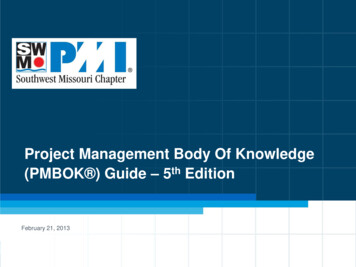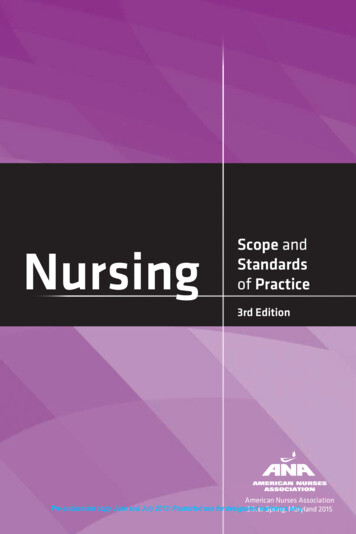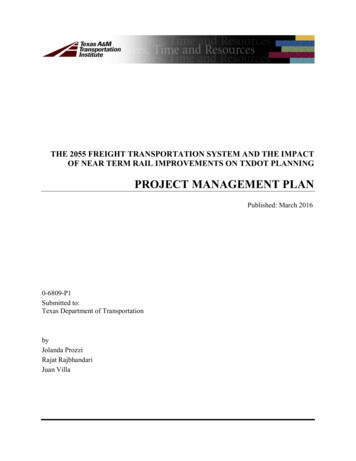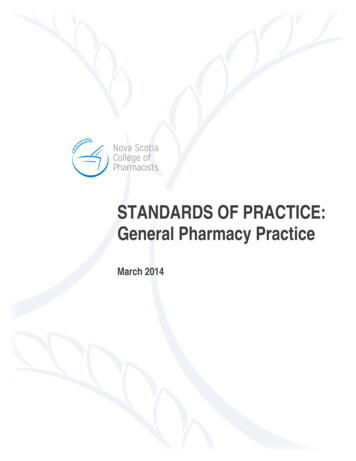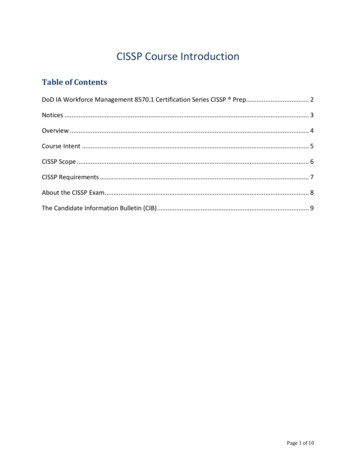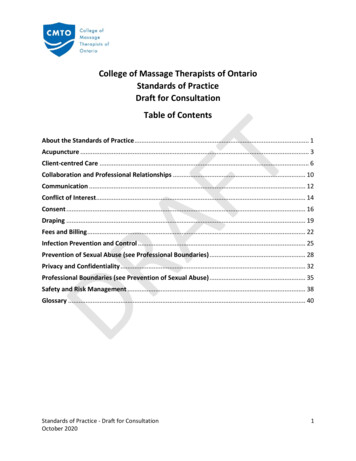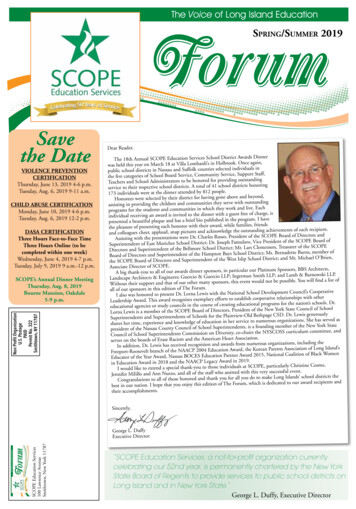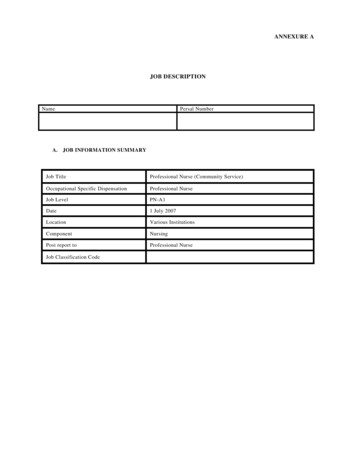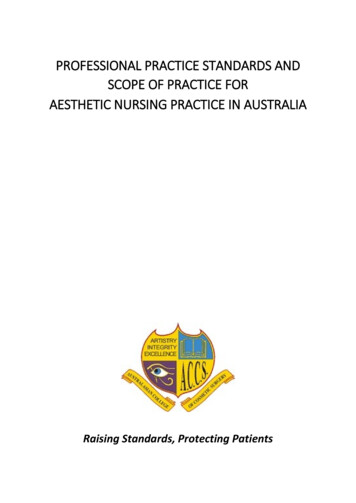
Transcription
PROFESSIONAL PRACTICE STANDARDS ANDSCOPE OF PRACTICE FORAESTHETIC NURSING PRACTICE IN AUSTRALIARaising Standards, Protecting Patients
Message from the President of the Australasian College of Cosmetic SurgeryThe Australasian College of Cosmetic Surgery is pleased to invite you toimplement the Professional Practice Standards and Scope of Practice forAesthetic Nursing Practice in Australia (2015). This document is the first of itskind in the cosmetic context and the Advisory Group is to be commended onthe quality of their work. We trust that you find it useful in your clinical andprofessional practice.Yours Faithfully,Dr Soo-Keat Lim FFMACCSAugust 2015Raising Standards, Protecting Patients The Right Medicine Pty Ltd 2015. All rights reserved. No part of this book may be reproduced or used in anyform or means, electronic or mechanical, including photocopying and recording, or by any information storageand retrieval system without permission in writing from the publisher.2 Page The Right Medicine Pty Ltd 2015
ContentsAcknowledgments. 5Advisory group . 5Australasian College of Cosmetic Surgery council members . 5Executive of council . 5Council. 5The evolution of aesthetic nursing practice . 6Table 1: Principles of cosmetic, skin rejuvenation and aesthetic nursing . 7Table 2: Examples of postgraduate study undertaken by cosmetic, skin rejuvenation andaesthetic nursing . 7Table 3: Activities of cosmetic, skin rejuvenation and aesthetic nurses . 7Development of the Standards and scope for aesthetic nursing . 8How to use the Standards and scope for aesthetic nursing . 9Principles of continuing professional development . 9PROFESSIONAL PRACTICE STANDARDS . 111.Adhere to health practitioner regulation. 11Nursing and Midwifery Board of Australia . 122.Work with safety and quality as a paramount principle in the delivery of clinical services . 133.Maintain client/patient confidentiality and privacy . 134.Obtain informed consent . 135.Maintain health records, considering information privacy and access . 146.Administer medicines safely and effectively . 147.Utilise medical devices safely and effectively . 148.Maintain a safe and healthy work place . 149.Maintain the principles of infection control . 1510. Obtain informed financial consent. 1511. Utilise technology-based patient consultations safely and effectively. 1512. Provide objective advice and dispense cosmeceuticals/medical grade skin care . 15SCOPE OF PRACTICE . 16Domain 1: Assess client, plan and deliver appropriate care . 16Domain 2: Administers botulinum toxin A safely and effectively. 17. . 17Domain 3: Administers filler and related products safely and effectively. 18Domain 4: Delivers laser, intense pulsed light and related therapies safely and effectively . 193 Page The Right Medicine Pty Ltd 2015
REFERENCES . 20APPENDIX A: Professional Practice Standards and Scope of Practice for Aesthetic Nursing Practice inAustralia Audit Tool . 234 Page The Right Medicine Pty Ltd 2015
AcknowledgmentsWe would like to acknowledge the Council of the Australasian College of Cosmetic Surgery forrecognising and enabling the implementation of the Professional Practice Standards and Scope ofPractice for Aesthetic Nursing Practice in Australia (2015). The Australasian College of CosmeticSurgery is committed to professional excellence in aesthetic nursing and has recently upgraded theirnurse membership opportunities by establishing a Faculty of Nursing to support high standards ofnursing practice, education and research.Advisory groupElissa O’Keefe RN NP FFACNP MASPSN ACCS Nurse Affiliate (Lead author)Sharon Griffiths RN Transitional Nurse Practitioner ACCS Nurse AffiliateSuzanne Hoitink RN ACCS Nurse AffiliateSherilee Knoop RN ACCS Nurse AffiliateKim Murphy RN Dip. of Cosmetic Nursing (ACCS) ACCS Nurse AffiliateAmanda Taylor RN ACCS Nurse AffiliateJennifer Vallance General Manager ACCSAustralasian College of Cosmetic Surgery council membersExecutive of councilPresident: Dr Soo-Keat Lim FFMACCSVice President: Dr Ron Bezic FACCSSecretary: Dr John McHugh FACCSTreasurer: Dr David Topchian FACCSCensor in Chief: Dr John Flynn FACCSCouncilDr Kee Lee Tan FFMACCSDr Irene Kushelew FFMACCSDr Meaghan Heckenberg FFMACCSDr Colin Moore FACCSDr Bernard Beldholm FACCSDr Ronald Feiner FFMACCS5 Page The Right Medicine Pty Ltd 2015
The evolution of aesthetic nursing practiceCosmetic medical and surgical procedures are defined as "operations and other procedures thatrevise or change the appearance, colour, texture, structure or position of normal bodily featureswith the sole intention of achieving what the patient perceives to be a more desirable appearance orboosting the patient’s self-esteem." (Australian Health Ministers' Advisory Committee, 2011) For thepurpose of this document the term “aesthetics” is used to encompass this definition but excludessurgical procedures. Cosmetic medical procedures are primarily performed by medical practitionersand nurses. The most common procedures are the administration of muscle relaxants into the faceand/or dermal filler for volume loss of the face, reduction of unwanted hair, non-invasive facialrejuvenation, chemical peels and skin resurfacing (International Society of Aesthetic Plastic Surgery,2015).In 2015 the International Association for Physicians in Aesthetic Medicine (IAPAM) reported aconsistent nine year growth in cosmetic medical procedures with the number of non-surgicalprocedures in 2014 compared to the previous year higher by 13.1% (IAPAM, 2015). TheInternational Society of Aesthetic Plastic Surgery report that worldwide in 2013 almost twelvemillion nonsurgical procedures were performed (International Society of Aesthetic Plastic Surgery,2015).These trends are evident in Australia and in 2011 the Cosmetic Physicians Society ofAustralasia reported that consumer spending on non- and minimally-invasive treatments hadincreased by 15% from the previous year and that there was a total estimated annual spend of 644.7 million (Cosmetic Physicians Society of Australia, 2012). This increased utilisation willundoubtedly be accompanied by an increasing incidence of adverse event reports and/or patientharm. A key purpose of this document is to minimise the incidence of these by provding aprofessional practice framework.The recognition and professional support for aesthetic nurses in Australia is in an evolutionaryphase. Neither the Australian Institute of Health and Welfare nor the Nursing and Midwifery Boardof Australia maintain statistics on the number of nurses working in aesthetics but conservativeestimates are in the many hundreds with a proportional increase over time predicted as consumerdemand for these services increase.The context of care for aesthetic nurses is variable. They can practice in collaboration with medicalcolleagues such as with cosmetic physicians, cosmetic or plastic surgeons or dermatologists inprivate or public healthcare settings. They can also work in nurse-led clinics or independently inprivate practice. Common domains within which they work include but are not limited to theprovision of skin care advice and referral, skin cancer checks, management of common skindisorders, prescription of medical grade skin care products, laser and other light based therapies,skin resurfacing, removal of benign lesions, dermal fillers, administration of muscle relaxants, skintightening and mesotherapy. It is implicit that a genuine clinical relationship will be fostered withother members of the health care team.The Professional Practice Standards and Scope of Practice for Aesthetic Nursing Practice in Australia(Standards and scope for aesthetic nursing) represents the first description of standards ofprofessional practice for aesthetic nurses in the Australian context and the knowledge and skillsrequired to confidently and proficiently deliver client care. It is acknowledged that the extent of anurse’s scope of practice is determined by the individual’s education, training and competence andthat the extent of it is then authorised in the practice setting by the employer’s organisationalpolicies and requirements (Nursing and Midwifery Board of Australia, 2015).Cosmetic, skin rejuvenation and aesthetic nursing was first described as a specialty in 2013 with thepublication of a nursing model of practice in this context in the Australian Nursing Journal (O’Keefe6 Page The Right Medicine Pty Ltd 2015
and Hoitink, 2013). In this article the authors provide some of the following information on theprinciples, post-graduate education and scope of practice.Table 1: Principles of cosmetic, skin rejuvenation and aesthetic nursing Nurses are registered with the Australian Health Practitioner Regulation Agency (AHPRA)Nurses should work within their scope of practice based on each nurse’s education,knowledge, competency, extent of experience and lawful authorityClinical care is governed by evidence-based standard operating policy and procedures/clinical practice guidelines or similarClients/patient presentations that fall outside the scope of practice of the nurse arereferred to an appropriate, competent person.Table 2: Examples of postgraduate study undertaken by cosmetic, skin rejuvenationand aesthetic nursing Accredited Laser Safety Officer’s CertificateDiploma in Cosmetic NursingVocational Graduate Certificate in Cosmetic NursingMaster of Clinical NursingMaster of Nurse PractitionerTable 3: Activities of cosmetic, skin rejuvenation and aesthetic nursesCare of the client for: Wound care Acne management Scarring Rosacea Anti-ageing/skin fitness Skin Sensitivity Sun damage Pigmentation Leg and facial capillaries Removal of unwanted hair Removal of benign skin lesions Skin tightening Referral to a specialist.Administration of: Dermal fillers Muscle/wrinkle relaxants Other scheduled medicines as required.7 Page The Right Medicine Pty Ltd 2015
Treatments: Intense pulsed lightLaser (including but not limited to Thulium/Erbium, Nd:YAG, Ruby, Alexandrite)MicrodermabrasionChemical peels (AHA, BHA, Jessner, TCA, Retinoid)Light Emitting Diode (LED) therapyRadiofrequency therapyDermal rollering/needlingPlatelet rich plasmaPhotodynamic therapyCosmetic tattooingTattoo removalSclerotherapyLipodissolvePrescribing medicinesThe United Kingdom (UK) (British Association of Cosmetic Nurses, 2013) and the United States ofAmerica (USA) (American Nurses Association, 2013) (American Society of Plastic Surgical Nurses Inc,2015) recognise that nurses working in a cosmetic medicine or aesthetic context are a specific cohortof the profession. In the UK they are referred to as ‘nurses in aesthetic medicine’ while in the USA‘non-surgical aesthetic nursing’ is recognised as being part of plastic surgical nursing. In the UK theBritish Association of Cosmetic Nurses (BACN) has been established since 2010. BACN have in excessof 600 members and have developed educational frameworks, competencies and training. TheirIntegrated Career and Competency Framework for Nurses in Aesthetic Medicine builds on a previous2007 RCN document and continues to be accredited by RCN (British Association of Cosmetic Nurses,2013). The American Society of Plastic Surgery Nurses (ASPSN) has been established since 1975 andhas in excess of one thousand members. The mission of ASPSN is to employ education and researchto promote practice excellence, nursing leadership, optimal patient safety, and outcomes by usingevidence-based practice as a foundation of care. They hosted their first aesthetic symposium in 2004and aesthetic nursing was affirmed as a significant part in their strategic direction at their 2014conference and board meeting. (American Society of Plastic Surgical Nurses Inc, 2015)Development of the Standards and scope for aesthetic nursingThe Professional Practice Standards and Scope of Practice for Aesthetic Nursing Practice in Australia(Standards and scope for aesthetic nursing) was developed after a professional cohort of nurseaffiliate members from the Australasian College of Cosmetic Surgery (ACCS) recognised a need todevelop an academic program. In the Nursing and Midwifery Board of Australia’s Specialistrecognition and the nursing profession project they identified that “specialist organisationsrepresenting speciality nursing groups in Australia have developed sound governance processes forspeciality practice. This provides an effective means of acknowledging advanced practice, and maybe recognised by employers and the health industry at large.” (Nursing and Midwifery Board ofAustralia, 2015) The development of a set of best practice standards such as these that will also8 Page The Right Medicine Pty Ltd 2015
inform education are in congruence with recommendations from the Australian Health Ministers’Advisory Council’s Clinical, Technical and Ethical Principal Committee Final Report (Australian HealthMinisters' Advisory Committee, 2011):1. Where nurses are administering scheduled drugs or undertaking other high risk proceduresin relation to cosmetic medical and surgical procedures, some as independent practitioners,that this should be done in accordance with applicable laws, protocols and best practicestandards2. In relation to nurses, treatment should only be provided if the nurse has appropriatetraining, expertise and experience in the procedure.The standards Advisory group and the Critical review panel were selected for their skills andexpertise in clinical practice, professionalism, educational background and their collaborative,‘forward thinking’ attitude. The framework is intended as a guide for practitioners and acknowledgesthat aesthetic nursing practice requires specific, unique knowledge and skills across a spectrum ofexperience levels. It is not presented as an exhaustive nor prescriptive document but as a prototypeto benchmark practice in the Australian context. The framework promotes the need to research,establish and review appropriate standards of education and training to enable safe and effectivepractice. It is intended as a voluntary and self-regulatory document.How to use the Standards and scope for aesthetic nursingThis framework has multiple uses:1. It sets the standard for what would be expected of nurses in an aesthetic context2. It enables career pathway development3. It can be used as an audit tool for both individual clinicians and supervisors and /oremployers to identify strengths, areas for development and to plan professionaldevelopment4. Where it has been used as an audit tool it can be used as evidence of continuing professionaldevelopment5. It can be used as a basis for role development, job descriptions and performance evaluation.Principles of continuing professional developmentThe Nursing and Midwifery Board of Australia (Nursing and Midwifery Board of Australia, 2015)assert that continuing professional development (CPD) is the means by which members of theprofessions maintain, improve and broaden their knowledge, expertise and competence, anddevelop the personal and professional qualities required throughout their professional livesFor evidence to be accepted by the Nursing and Midwifery Board of Australia as quality CPD a nursewill have to show evidence that they have: Identified and prioritised their learning needs, based on an evaluation of their practiceagainst the relevant competency or professional practice standardsDeveloped a learning plan based on identified learning needsParticipated in effective learning activities relevant to their learning needsReflected on the value of the learning activities or the effect that participation will have ontheir practice.9 Page The Right Medicine Pty Ltd 2015
The documentation that is required to have been collected in order to demonstrate the CPDactivities include: DateSource or provider detailsIdentified learning needsAction planType of activityDescription of topic/s covered during activity and outcomeReflection on activity and specification to practiceNo./Title /Description of evidence providedCPD hours.Appendix A, the ‘Professional Practice Standards and Scope of Practice for Aesthetic Nursing Practicein Australia Audit Tool’ has been developed to be used as a self-assessment tool against thestandards and to inform the CPD process.10 P a g e The Right Medicine Pty Ltd 2015
PROFESSIONAL PRACTICE STANDARDS1. Adhere to health practitioner regulationNurses are required to adhere to health national and state/territory health practitioner regulatoryrequirements.QueenslandHealth Practitioner Regulation National Law Act 2009 (Queensland Government, 2009). (All Statesand Territories have enacted the National Law.)Health Ombudsman Act 2013 (Queensland Government, 2013)New South WalesHealth Practitioner Regulation National Law (NSW) No 86a (NSW Government, 2014)VictoriaHealth Practitioner Regulation National Law (Victoria) Act 2009 (State Government Victoria, 2009)Australian Capital TerritoryHealth Practitioner Regulation National Law (ACT) Act 2010 (ACT Government, 2012)Northern TerritoryHealth Practitioner Regulation (National Uniform Legislation) Act 2010 (Northern TerritoryGovernment, 2010)TasmaniaHealth Practitioner Regulation National Law (Tasmania) Act 2010 (Tasmanian Government, 2010)South AustraliaHealth Practitioner Regulation National Law (South Australia) Act 2010 (Government of SouthAustralia, 2010)Western AustraliaHealth Practitioner Regulation National Law (WA) Act 2010 (Government of Western Australia, 2010)11 P a g e The Right Medicine Pty Ltd 2015
Unregistered practitionersAesthetic nurses work with a variety of registered and unregistered health professionals and shouldunderstand the Codes of Conduct related to unregistered practitioners in their relevant State orTerritory. New South Wales (NSW Government, 2012) and South Australia (Government of SouthAustralia SA Health, 2013) have a Code of Conduct for unregistered health practitioners and there iscurrently a consultation regarding national harmonisation of such Codes (Council of AustralianGovernments Health Council, 2015).Nursing and Midwifery Board of AustraliaNurses are supported in their professional practice with regard to both clinical and professionalgovernance through the Nursing and Midwifery Board of Australia whose responsibility it is forregulating Australia's nurses and midwives. Overarching governance documents can be found in thefollowing:Codes Codes of ethicsCodes of professional conductIt can be noted here that the Australian Health Ministers’ Advisory Council’s Clinical, Technical andEthical Principal Committee recommend that the Nursing and Midwifery Board of Australia considerthe need for the development of supplementary guidelines to its Code of professional conduct,specifically dealing with cosmetic medical and surgical procedures but these have not beendeveloped as yet. (Australian Health Ministers' Advisory Committee, 2011)Guidelines Competency standardsDecision making frameworkGuidelines for registration standardsProfessional indemnity insurance arrangementsProfessional practice guidelinesProfessional boundariesGuidelines for advertising regulated health servicesGuidelines for mandatory notificationAgain it can be noted that the Australian Health Ministers’ Advisory Council’s Clinical, Technical andEthical Principal Committee recommended that the Nursing and Midwifery Board of Australiamonitor compliance with the Guidelines for advertising regulated health services particularly inrelation to nurses practising independently and offering cosmetic medical procedures. (AustralianHealth Ministers' Advisory Committee, 2011)12 P a g e The Right Medicine Pty Ltd 2015
Policies Social mediaPosition statements Position statement on scope of practice of nurse practitioners - November 2013Position statement on concurrent registration as an enrolled nurse and registered nurse May 2011. (Nursing and Midwifery Board of Australia, 2015)2. Work with safety and quality as a paramount principle in the delivery of clinicalservicesIn the Cosmetic Medical and Surgical Procedures a National Framework: Final Report (AustralianHealth Ministers' Advisory Committee, 2011) it is clear that cosmetic medical and surgicalprocedures “wherever they occur in Australia, must be in accordance with key national safety andquality health service standards (e.g. infection control)”. (ACSQHC, 2013) Nurses should be updatingtheir CPR annually with consideration of advanced resuscitation training depending on the contextof care.3. Maintain client/patient confidentiality and privacyNurses are legally and ethically required to maintain confidentiality which protects against disclosureto an outside person of any information revealed in a professional relationship, e.g. nurse-patient.(Australian Government ComLaw, 1988). In some jurisdictions breach of confidentiality may be acriminal offence. Local policy and procedures may also influence the management of confidentialinformation. Nurses are required to adhere to the Privacy Act, Privacy Amendment and PrivacyRegulations (Australian Government ComLaw, 2012) (Australian Government ComLaw, 1988)(Australian Government ComLaw, 2013)4. Obtain informed consentInformed consent is a person’s voluntary decision about medical care that is made with knowledgeand understanding of the benefits and risks involved (Medical Board of Australia, 2014). To obtaininformed consent nurses disclose the nature of the procedure, alternatives, and risks in anydiscussion and consider the following elements (1) the patient's role in decision making, (2) thenature of the decision, (3) alternatives, (4) pros (benefits) and cons (risks) of the alternatives, (5)uncertainties associated with the decision, (6) an assessment of the patient's understanding of thedecision, and (7) an exploration of the patient's preferences (Braddock, et al., 1999). They are awareof the special considerations associated with children and young people and clients who may haveadditional needs. Nurses also consider that clients need time to reflect before and after they havemade a decision (General Medical Council, 2015).13 P a g e The Right Medicine Pty Ltd 2015
5. Maintain health records, considering information privacy and accessHealth records, information privacy and access is determined by State and Territory based legislationand also local guidelines within which nurses are required to operate.6. Administer medicines safely and effectivelyMedicines are controlled across Australian States and Territories by specific Poisons Acts withaccompanying regulations that specify the legal obligations with regard to the administration ofmedicines for nurses and other health professionals (ACT Government; Parliamentary Counsel, 2013)(State Government Victoria, 1981) (NSW Government, 2014) (Government of Western Australia,2014) (Northern Territory of Australia, 2014) (Queensland Government, 2014) (Government of SouthAustralia, 2011) (Tasmanian Government, 2012). The national medicines framework the NationalMedicines Policy (Australian Government Department of Health, 2000) strives for “better healthoutcomes for all Australians, focusing especially on people’s access to, and wise use of, medicines.The term “medicine” includes prescription and non-prescription medicines, includingcomplementary healthcare products.” It has at its core the following principles important for nursesto consider when administering medicines whether prescription or non-prescription: timely accessto the medicines that Australians need, at a cost individuals and the community can afford;medicines meeting appropriate standards of quality, safety and efficacy; quality use of medicines;and maintaining a responsible and viable medicines industry.Nurses are required to fulfil their responsibilities with regard to managing adverse events related tomedication through well-established regulatory mechanisms (Australian Government Department ofHealth TGA, Reporting medicine and vaccine adverse events, 2014). Local standard policy andprocedure in the prescription, supply, storage, administration, recording and disposal of medicines isessential in supporting good clinical practice.7. Utilise medical devices safely and effectivelyA minimum qualification of a ‘Laser Safety Officer’s Certificate’ endorsed by State/TerritoryRadiation Health Departments is recommended as a minimum requirement for operating lasers,intense pulsed light and other light based therapies.Nurses are required to identify their responsibilities with regard to managing adverse events relatedto devices (Australian Government Department of Health TGA, Report a medical device adverseevent (medical device user), 2014)There are Australian and New Zealand Standards that apply to the use of lasers some of which arereferred to in legislation or codes. (SAI Global, 2001) (SAI Global, 2009) (SAI Global, 2004) (SAIGlobal, 2004) (SAI Global, 2003) (SAI Global, 2011) (SAI Global, 2004)8. Maintain a safe and healthy work placeAesthetic nurses have health and safety duties and rights at work. The Australian Work Health andSafety Strategy 2012-2022 “provides a framework to drive improvements in work health and safetyin Australia. It promotes a collaborative approach between the Commonwealth, state and territorygovernments, industry and unions and other organisations to achieve the vision of healthy, safe and14 P a g e The Right Medicine Pty Ltd 2015
productive working lives.” (Safe Work Australia, 2012) Safe Work Australia coordinates and developsnational policy and strategies, assists with the implementation of model work health and safetylegislation and reform the legislative framework, undertakes research and collects, analyses andreports data.9. Maintain the principles of infection controlUnderstanding the transmission of infectious organisms and knowing how and when to apply thebasic principles of infection prevention and control is critical to infection control in any health caresetting and this responsibility applies to nurses in aesthetics. (Australian Government NHMRC, 2010)10. Obtain informed financial consentNurses in aesthetic nursing are required to obtain informed financial consent from their clients.According to the Australian Government Department of Health “Informed financial consent is theprovision of cost information to patients, including notification of likely out-of-pocket expenses(gaps), by all relevant service providers, preferably in writing, prior to admission to hospital ortreatment (Australian Government Department of Health, 2008).”11. Utilise technology-based patient consultations safely and effectivelyTelehealth consultations are recognised as a valid tool to provide health care lishing.nsf/Content/e-health-telehealth. Nurses arerequired to understand the principles of technology-based patient consultations and how they applyto their context of practice. Technology-based patient consultations are patient consultations that“use any form of technology, including, but not restricted to videoconferencing, internet andtelephone, as an alternative to face-to-face consultations”. (Medical Board of Australia, 2012)12. Provide objective advice and dispense cosmeceu
Practice for Aesthetic Nursing Practice in Australia (2015). The Australasian College of Cosmetic . The evolution of aesthetic nursing practice Cosmetic medical and surgical procedures are defined as "operations and other procedures that revise or change the appearance, colour, texture, structure or position of normal bodily features .
